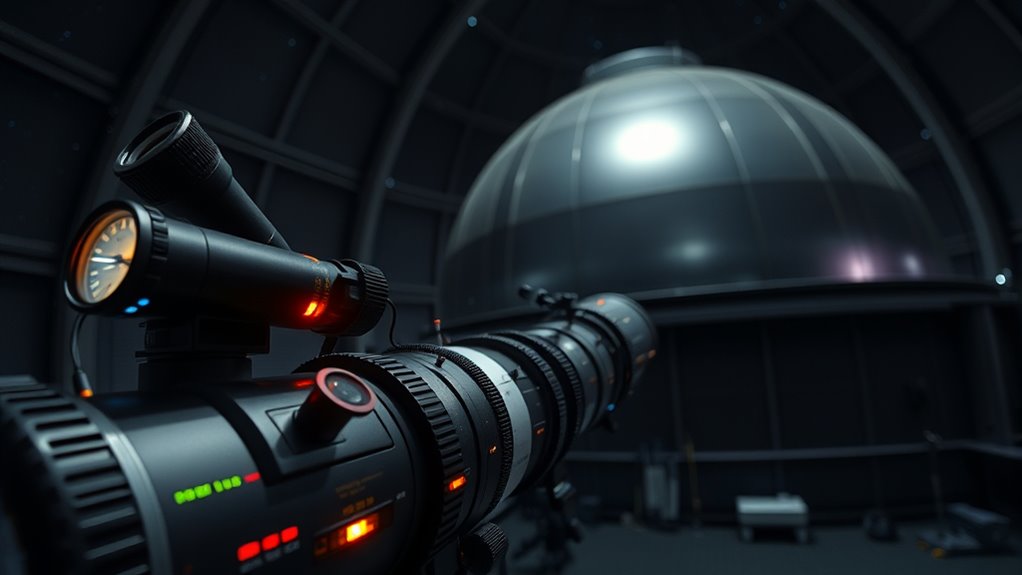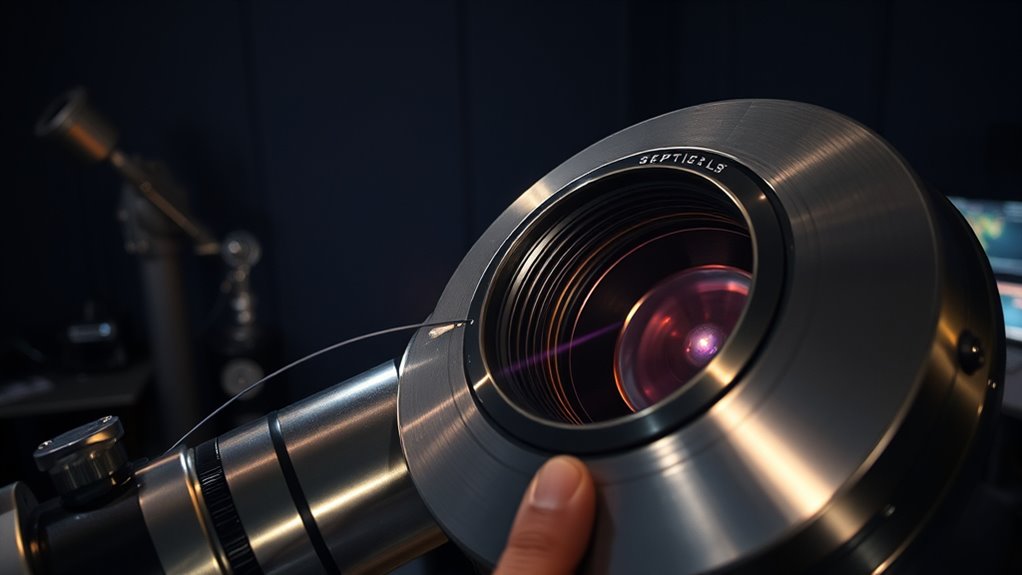Spectroscopy helps you detect exoplanets by measuring tiny shifts in a star’s spectral lines caused by its gravitational wobble. When a planet orbits a star, it pulls gently on it, creating movement toward or away from you. This motion causes a Doppler shift in the star’s light, showing as blue or red shifts. By carefully observing these shifts over time, you can uncover the presence of unseen planets. Keep exploring to discover how this powerful technique *reveals* the secrets of distant worlds.
Key Takeaways
- Spectroscopy detects exoplanets by observing tiny Doppler shifts in a star’s spectral lines caused by gravitational wobble.
- The radial velocity method measures periodic red and blue shifts indicating a star’s motion due to orbiting planets.
- High-resolution spectroscopy is essential to identify small spectral shifts corresponding to distant exoplanets.
- Monitoring spectral line variations over time reveals the presence, mass, and orbital characteristics of exoplanets.
- Advances in spectroscopic technology have significantly improved the ability to discover and study exoplanets beyond our solar system.

Spectroscopy in astronomy is a powerful tool that allows scientists to analyze the light from celestial objects and uncover their secrets. When you observe distant stars, the light reaching your telescopes carries a wealth of information encoded in its spectral lines—the distinct fingerprints of elements within those stars. By examining these spectral lines, you can identify the composition, temperature, and motion of celestial bodies. One of the key phenomena used in this process is the Doppler shift, which occurs when an object moves relative to you. If a star moves toward you, its spectral lines shift slightly toward shorter wavelengths, known as a blueshift. Conversely, if it moves away, the lines shift toward longer wavelengths, called a redshift. These shifts provide crucial clues about the star’s motion.
When searching for exoplanets, you focus on detecting the subtle influence they have on their host stars. As a planet orbits, its gravitational pull causes the star to wobble slightly. This wobble affects the spectral lines in the star’s light, shifting them back and forth due to the Doppler effect. When the star moves toward you because of the planet’s gravitational tug, its spectral lines shift toward the blue; when it moves away, the lines shift toward the red. By carefully measuring these shifts over time, you can determine the presence of an orbiting planet, its mass, and its orbital period. This method, known as the radial velocity technique, hinges on detecting these tiny Doppler shifts in spectral lines.
The process involves high-resolution spectroscopy, which allows you to see even the smallest changes in the spectral lines. These shifts can be incredibly subtle—sometimes just a few parts in a million—so precise instruments are essential. As you monitor a star over months or years, patterns emerge in the spectral line shifts, revealing the gravitational influence of an unseen companion. This technique has led to the discovery of many exoplanets, especially those close to their stars, which induce more pronounced stellar wobbles.
Understanding the importance of instrumentation is critical, as advances in spectroscopic technology continually improve our ability to detect these tiny signals. In essence, by analyzing spectral lines and measuring Doppler shifts, you can uncover planets orbiting distant stars that would otherwise remain hidden. This application of spectroscopy transforms faint light signals into a window revealing worlds beyond our solar system, demonstrating the power of light analysis in expanding our understanding of the universe.
Frequently Asked Questions
How Do Spectroscopic Techniques Differentiate Between Planets and Stars?
You differentiate between planets and stars by analyzing spectral lines and Doppler shifting. When observing a star, you notice slight shifts in spectral lines caused by the star’s motion, indicating an orbiting planet’s gravitational pull. Planets themselves don’t emit significant light but cause these subtle spectral line variations. By carefully examining these Doppler shifts over time, you can confirm the presence of a planet and distinguish it from the star’s own spectral features.
What Are the Limitations of Spectroscopy in Exoplanet Detection?
You might think spectroscopy can detect all exoplanets, but its limitations stem from instrument sensitivity and spectral resolution. If your instruments aren’t sensitive enough, faint signals get lost, missing small or distant planets. Low spectral resolution can blur key details, making it hard to distinguish planetary signals from stellar noise. These factors restrict your ability to find certain exoplanets, especially Earth-like ones, highlighting the need for advanced technology.
How Does Atmospheric Interference Affect Spectroscopic Observations?
Atmospheric distortion can considerably affect your spectroscopic observations by causing the light from exoplanets to scatter or bend, reducing data clarity. This interference makes it harder to detect subtle spectral signals. To counter this, you should use interference mitigation techniques like adaptive optics or space-based telescopes, which help minimize atmospheric effects and improve the accuracy of your spectroscopic measurements.
Can Spectroscopy Identify Exoplanet Atmospheres’ Chemical Compositions?
Sure, spectroscopy can reveal the chemical compositions of exoplanet atmospheres—if you can decipher the elusive spectroscopic signatures amid the cosmic noise. It’s almost poetic how atmospheric analysis allows you to identify gases like water vapor or methane, turning faint light into a detailed chemical map. So yes, through careful observation of these signatures, you can uncover the secrets of distant worlds’ atmospheres, one spectral line at a time.
What Advancements Are Expected in Spectroscopic Technology for Astronomy?
You can expect advancements like enhanced resolution and adaptive optics to revolutionize astronomical spectroscopy. These improvements will allow you to observe fainter objects and finer details in exoplanet atmospheres, making it easier to identify chemical compositions. As technology progresses, you’ll benefit from more precise data, enabling deeper insights into distant worlds and their environments, ultimately expanding our understanding of the universe and potentially habitable planets.
Conclusion
Spectroscopy in astronomy is like a superpower that helps you uncover hidden worlds beyond our solar system. By analyzing starlight, you can detect the presence of exoplanets as easily as spotting a tiny boat on a vast ocean. This technique opens a window to new planets and potential life, making you feel like a cosmic detective. With each discovery, you get closer to understanding the universe’s mysteries, turning the unknown into exciting possibilities.









